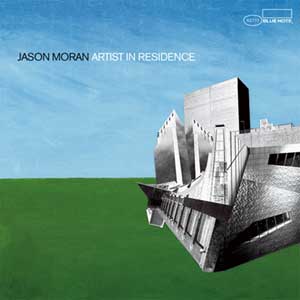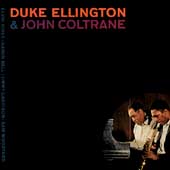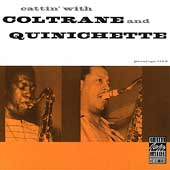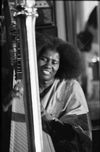
There is a steely confidence about Jason Moran... which manifests not just in his performance on piano but in his wider conceptual ambitions... For example: the origins of the music on his new CD for Blue Note, 'Artist in Residence,' are in three recent commissions from the American art world. The Walker Art Center commission 'Milestone' was an engagement with the life and work of Adrian Piper, specifically 'The Mythic Being: I/You (Her).' To quote from her website:
'Adrian Margaret Smith Piper is a conceptual artist whose work, in a variety of media, focused on racism, racial stereotyping and xenophobia for over three decades; and now investigates the deeper spiritual and ideological pathologies that cause them.' (Quoted from here...).
The Dia Art Foundation material comes from 'The Shape, the Scent, the Feel of Things,' created in collaboration with the performance and video artist Joan Jonas who 'uses unlikely combinations of objects to create performances that are concerned with the image as metaphor. ' (Quoted from here...).
'RAIN' originated in a commission for sextet from Jazz at Lincoln Center.
Moran took a selection of all this material and condensed it down to one CD – which acts as a succession of snapshots from the larger works. Can we group these snapshots into a coherent whole, considering the obvious lack of the visual/theatrical elements? We shall see...
A significant amount of his work has been inspired by artists such as Egon Schiel, Robert Rauschenberg and Jean-Michel Basquiat. So, engaging with the art world is a logical and conscious strategy to reach out beyond the boundaries of what we can loosely still just about call 'jazz' – as problematic a word as 'art.' Moran, arguably, wants 'jazz' to be regarded as 'art' – but on its own terms, with respect for its history. This is not obeisance to the academy but negotiation... from strength. Within the boundaries of the 'jazz' tradition he is also moving backwards and forwards while incorporating currents from outside - hip hop for example and sampling techniques. These trajectories – which amount to an overall call for free artistic interchange between idioms and cultures 'high' and 'low' - are encapsulated on the first track:
'Artist in Residence' opens with what could be regarded as a manifesto (in the tradition of 'art') - 'Breakdown' – using the sampled voice of Adrian Piper as the piano shadows the vocal movement, over a strong back beat, the piano slowly edging out into rolling lines, some hammered low register chords as the drums breakdown from the hip-hop inflected rhythm and erupt into freer rolling pulses - Piper declaims: 'Breakdown the barriers,' ...'The misunderstandings...' Break down the barriers between idioms? 'Artist in Residence' proceeds to do just that... A funky start...
In contrast – 'Milestone' (echoes of Miles...) - a slow elegaic intro and the soprano voice of Alicia Hall Moran comes in – classically trained and singing with elegant grace – name-checking European cities as if in recognition of her 'orthodox' musical origins: 'London, Paris, Brussels, too' – then rolling drums rising and bass doubling behind the piano – the guitar of Marvin Sewell imitates the voice timbres and melodic movement in swooping figures as the piano expands rhapsodically. This track reminds me - glancingly - of Steve Lacy - his take on 'art songs' in partnership with his wife Irene Aebi. (Lacy also took much inspiration from artists – Paul Klee, for one). 'Milestone' is less angular than Lacy's work, but has much warmth and beauty and manages to create a space where classical voice and jazz can co-exist easily (a deliberate echo of the Morans' marital relationship?).
'Refraction 2.' Jazzy bass bounces over washing electronic soundscape followed by the piano riffing in – some stomping playing here as the Bandwagon jumps – Waits giving his percussive all towards the end. One of the tactics you notice throughout this album is the way in which often simple riffs/repeated figures are used to expand outwards to build complicated structures and movement – an ever-expanding circling dance which could stand as the overall image for this project, perhaps?. More of this later...
'Cradle Song' – out of the cradle endlessly rocking... a gentle piano sounds as scratching noises obtrude – a mirror of memory – his late mother used to make pencil notes as he practised/played... But: if you did not know what the extraneous noise is, how would you link it to the overall thrust of the piece? This is after all a private resonance – the gap between original performance and studio recreation minus the visual/explanatory dimension shows here. Yet: once you are aware of the original intention, it does add to the experience by creating a poignant image... The piano builds in a powerfully emotional rendering as the pencil scratching ceases – leaving that trace of sad memory in its absence.
'Artists ought to be writing.' Continuing the theme of breaking down the barriers – a plea for wider understanding of the artist's life –' if the artist's ideas were more accessible to the general public I think it might break down some of the barriers etc'– the speech rhythms of Adrian Piper subtly matched and interlaced with the piano's falling and rising... which comments interestingly on the words and eventually leaves them behind – is there a subtle conflict going on here? That however much one tries to explain verbally, music will always go beyond. 'All art constantly aspires towards the condition of music,' in the often-quoted words of Walter Pater. (From 'The School of Giorgione,' online source here...). Piper comes across a little overwrought, maybe – but the point she makes rather didactically ('artists should be...' Well – why should they be? Discuss...) is valid enough – perhaps - in the overall theme of breaking down barriers and Moran's use of her voice on this track is fascinating in its endeavour.
'Refraction 1' opens with slow ringing treble figures as Joan Jolas's lightly pattering, scraping and sporadic ringing percussion comments. Moran has to play through her rather than with her – coming into a lurching left hand stop-start rhythm as he fires off streams of single notes and chords. The percussion becomes busier to match the rising volume and complexity of the piano – in emotional intent rather than matched technical facility. Not sure about this track – maybe the live performance and visual dimension help this piece although Moran's playing is as ever immaculate. Break down the barriers between professional and amateur musicians, anyone?
'Arizona Landscape' – solo piano - a loping bass – from an archetypal western soundtrack – crossed with a distant murmur of boogie woogie? Echoes of: Sonny Rollins, intentional or otherwise ('I'm an old cowhand' etc)... meets John Ford – with an odd resonance of Woody Guthrie's 'Pastures of Plenty' in the tune (maybe this is unintentional). Cinematic in range, ironic in tone:
'I'm, like, a big movie fanatic. I watch a lot of movies all the time. And I'm always listening to the soundtracks in the background, behind certain scenes or just the soundtrack in general, the pieces that they choose to support a scene. ' (From an interview with Fred Jung here... ).
Moran said in another interview that one of the things he admired about Jaki Byard and two other musicians who were strong influences was their use of the whole keyboard – 'Those cats, Jaki, along with Andrew and Muhal, they use the entire piano.' (From am interview with Fred Jung here...). This panoramic wide-open keyboard skill is appropriately (given the spatial/desert theme) on display here. Moran is an exceptionally good solo player – two fisted meaty stuff.
'Rain'.
'After a regular worship service, congregations used to stay for a “ring shout”. It was a survival of primitive [sic] African dance. So, educated ministers and members placed a ban on it. The men and women arranged themselves in a ring. The music started, perhaps with a Spiritual, and the ring began to move, at first slowly, then with quickening pace. The same musical phrase was repeated over and over for hours. This produced an ecstatic state. Women screamed and fell. Men, exhausted, dropped out of the ring. (Quoted from here...).
Begins with rustling footsteps in evocation of the above-described ring shout or ring dance, then a mournful trumpet (Ralph Alessi) proceeds to state and repeat a six bar theme followed by piano, bass, eventually soft drums, ensemble slowly coming together. The tempo starts to accelerate, changing key and the drums become more involved spurring the song along with pouncing keyboard interjections. The trumpet is gradually overwhelmed by the now-rampaging piano-led ensemble, being slowly buried in the mix, as if having heaps of sound tossed over it. Slowing down again to a mainly backbeat driven section with the trumpet emerging and hiding and re-emerging to restate the theme - finally to solo over pedal driven chords moving round an insistent e flat. Possibly the ebbing and flowing of the trumpet volume is deliberate as in the original live performance he was circling the group onstage in emulation of the dance the piece was inspired by. A seamless transition as the rhythm stretches into another fiery freed-up section, that evokes the trangressive nature of the older African ritual coming through the newer framework of the adopted Christian religion – 'educated ministers placed a ban on it' - all finally reining back the volume and tempo as the rustling footsteps return ... the circle is completed. A highly accomplished ensemble piece - Abdou Mboup's contribution (on djembe, kora, talking drum) and Marvin Sewell's guitar adding to the overall colourations rather than being sharply-defined voices.
'Lift every voice' – a slow rolling beginning, the guitar vocalising a melismatic line over the gospel-style piano as they pay homage to James and John Wheldon Johnson's historic song. ( the lyrics are here...). Hammered low register piano – as emotional single note lines spin out behind the guitar's pleading urgency. Drifting almost imperceptibly into a strong swinging four four – nice guitar again from Sewell here – bluesy and vocally testifying, playing with timbres as the trio go into a repeated four bar section – some bass double-timed rippling high to low before a rather abrupt fade out stop. This track was not part of the original three commissions, but, given its historic significance, dovetails in neatly.
'He puts on his coat and leaves.' Solo piano – reflective over a left hand vamp, variations building and overlapping. Like someone building a structure before you, starting with the foundations and moving upwards and outwards until a light treble fall back collapses it and signals the end of the track - and the album - on a peaceful chord that - fancifully - puts on its coat – and leaves... An understated ending...
A creative musician has always had to be aware of his/her tradition – and be able play their way through it to discover their own ground, by omission or inclusion or a combination of both... To complicate things further, contemporary music – and what used to be called 'jazz' especially - has evolved and fragmented to the point where an often overwhelming number of streams run into it, further speeded up in recent years by the immediacy of global technology. To incorporate them with ease – and finesse– on the journeys through the territory - that's the trick. From Hip-Hop to High Art and all 'jazz' stations in between. Has Jason Moran succeeded here? By and large – yes. His ambition is no small thing – so it is not surprising that here and there it overreaches itself. But that is a minor quibble. Overall, I think that the selections from different performances, apart from acting as a valuable record, do adhere better than might be expected, because they have a couple of themes moving through that help to create an albeit fragile unity. For example, the long and troubled journey of African-American history and culture, from the ring-shouts of slavery (and before) to the modern Art commission. And on a different but linked trajectory, the urge to 'breakdown the barriers' between the walls that surround high art/the museum/the gallery and the wider public and their vernacular social musics – hip-hop, for example – with 'jazz' – at times elitist, especially since the emergence of a conscious avant-garde, at times popular/social - standing in an uneasy position in the middle. Interestingly, the album does not describe a straight line – rather it enacts (appropriately) a circular dance to widen out the musical field. Performed with a warm generosity that flows from the firm confidence of Moran's artistic conception. Compositionally, this is echoed - by taking often fairly minimal material and expanding it out... as a complex dance builds from individual footsteps... Arguably, in the specific jazz tradition of his chosen antecedents ...'Monk was my first [major influence]...' (from an interview with Fred Jung here...).
Which brings us back to history in a convenient circle dance of my own... Monk, of course, was mightily aware of his antecedents. As was another of Moran's mentors – Jackie Byard.
'He [Byard] embodied what every essential pianist should embody. He could grasp anything from stride to ragtime to some very free jazz. ' (Ibid).
This inclusiveness is the hallmark of Moran's playing and composing, the ability to incorporate sometimes conflicting material into an overall vision that looks back with respect to often forgotten and neglected origins – and forwards to new syntheses, new ideas, utilsing new technologies... Often, when 'jazz' has engaged with 'art,' the results have been forced or dry and arid. Apart fom a few small wobbles here and there – in the overall scheme, a risk worth taking – Moran avoids this significantly on this CD, his own exemplary playing helped by the tight cohesion and complementary instrumental skills of Tarus Mateen, Nasheet Waits in his core unit, the Bandwagon, and the contributions of his guests, especially Marvin Sewell's guitar and Ralph Elessi's trumpet playing on 'Rain.' Further, the decision to take this music out of its original contexts was an interesting gamble – given the quality of conception and performance on 'Artist in Residence', this has paid off handsomely...
Jason Moran – Artist in Residence.
(Jason Moran – piano; Marvin Sewell - guitar; Tarus Mateen – bass; Nasheet Waits – drums; Alicia Hall Moran – vocals; Adrian Piper – sampled voice; Joan Jonas – percussion (bells, shakers, toy car, claves); Abdou Mboup – djembe, kora, talking drum; Ralph Alessi – trumpet)
You can buy the CDhere...




